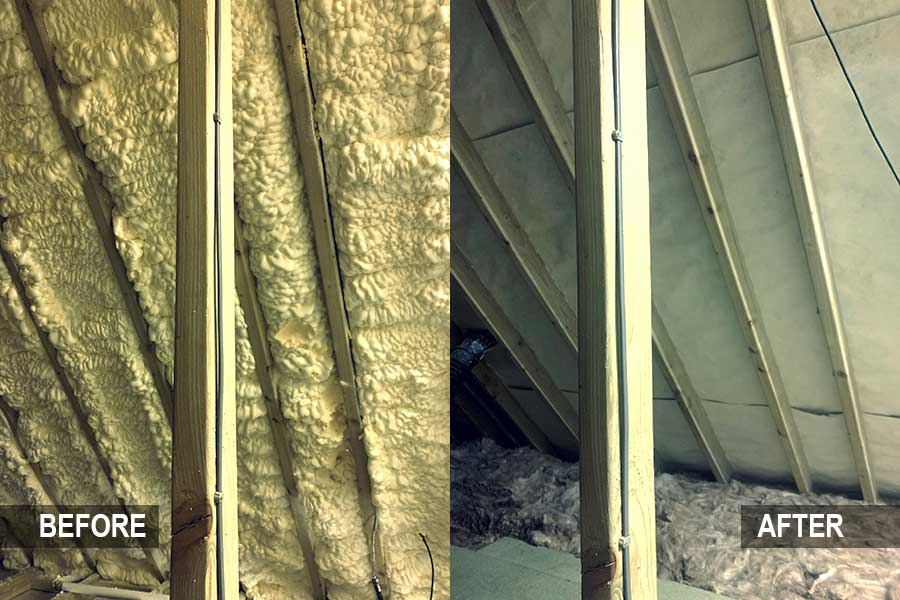Removing spray foam insulation is often more complicated and risky than it seems, and it’s something homeowners should approach with caution. Attempting to do it yourself can result in property damage, missed spots, and exposure to harmful particles and vapors. Hiring trained professionals is usually the safest route—they come equipped with the right tools and know-how to handle the job thoroughly, while also taking care of safe and responsible disposal.
Why Is Spray Foam Removal Suddenly So Important?
The Hidden Dangers of Spray Foam
Imagine wrapping your roof beams in clingfilm — it sounds ridiculous, right? Well, that’s basically what spray foam does. It creates an airtight barrier that traps moisture inside your roof structure. Over time, that moisture causes timber rot, encourages mould growth, and compromises your roof’s structural integrity.
Mortgage and Property Sale Issues
Here’s the kicker: most UK mortgage lenders now reject homes with spray foam insulation, especially in the loft. That means if you plan to sell or refinance, spray foam could block your sale or tank your valuation.
What Is Spray Foam Insulation and Why Was It Popular?
Benefits of Spray Foam That Made It Trendy
Back in the day, spray foam was the darling of energy efficiency. It offered:
- Great thermal performance
- Air-tight sealing
- Reduced heating bills
It sounded like a dream solution.
Where Things Went Wrong
But dreams turned into nightmares when surveyors couldn’t inspect roof timbers and started flagging spray foam as a potential danger. Combine that with unregulated installations and improper applications, and it’s now seen as a liability.
Why Mortgage Lenders Are Saying No to Spray Foam
The Surveyor’s Dilemma
Surveyors can’t see through foam. So, they can’t guarantee your roof timbers are in good shape — and that’s a problem. If there’s damage hidden underneath, it becomes a huge risk for the buyer and the lender.
Lender Liability and Insurance Concerns
Lenders don’t want to take chances on unseen issues, and neither do insurers. That’s why many refuse to finance homes with spray foam. For you, that could mean no remortgage, no buyer, no sale.
How to Know If You Need Spray Foam Removal
Signs Your Property Might Be at Risk
- Your loft has visible spray foam
- You’ve been denied a remortgage or sale
- Surveyors have raised red flags
- You’re experiencing roof ventilation issues or musty smells
Getting a Professional Assessment
If any of the above apply, it’s time to get a professional survey. Many companies, like Remove Spray Foam Ltd, offer free, no-obligation assessments.
How Spray Foam Removal Works: Step-by-Step
Types of Spray Foam: Open vs Closed Cell
- Open-cell foam: Soft, sponge-like, easier to remove
- Closed-cell foam: Hard, rigid, tougher to get off and bonded tightly to the roof structure
Safe Removal Techniques
Avoid dry ice blasting — it can damage your roof. Reputable companies use manual and mechanical methods with precision tools to carefully strip the foam layer by layer.
Tools and Timeframes
Expect a professional job to take 2–5 days, depending on size and foam type. Tools used may include saws, scrapers, and vacuums — all designed to protect your roof.
Why DIY Spray Foam Removal Is a Bad Idea
The Risk of Damaging Your Roof
Spray foam removal isn’t like peeling wallpaper. You could easily tear insulation membranes, crack rafters, or even expose your home to leaks.
The Health and Safety Hazards
Old foam can release particulates and fumes. Without proper safety gear and disposal procedures, you’re putting your health at risk.
Choosing the Right Spray Foam Removal Company
What to Look For in a Specialist
- Check-a-Trade or Trusted Trader members
- 1000+ completed removals
- No-deposit terms
- Full liability insurance
- Eco-friendly waste disposal
Questions to Ask Before Hiring
- Do you offer a free survey?
- How do you remove closed-cell foam?
- Are you certified or accredited?
- Do you provide before-and-after documentation?
Costs Involved in Removing Spray Foam Insulation
What Influences the Price
- Type of foam (open vs closed-cell)
- Size of loft area
- Access difficulty
- Need for re-roofing or repairs
Realistic Budget Ranges
- Open-cell foam: £3,000–£10,000
- Closed-cell foam: £10,000–£50,000
(Yes, it can get pricey — but it unlocks the full value of your home)
Benefits of Removing Spray Foam
Making Your Home Mortgageable Again
Removal often results in an instant increase in property saleability. Buyers come back, valuations rise, and remortgages go through without a hitch.
Improving Ventilation and Health
Once removed, your loft can breathe again. Moisture escapes, air quality improves, and you reduce the risk of mould, mildew, and rot.
What Happens After Spray Foam Is Removed?
Re-Insulating Your Loft the Right Way
Replace old foam with mortgage-friendly insulation like fibreglass or SuperFoil. These materials are breathable, effective, and don’t mess with your roof structure.
Final Inspections and Documentation
Your removal company should offer completion certificates, photos, and written confirmation that spray foam has been safely and completely removed — helpful for future sales or financing.
Conclusion: Take Back Control of Your Home
Spray foam might have felt like a shortcut to energy efficiency, but it’s turned into a massive roadblock for thousands of homeowners. If you want to unlock your property’s full potential, protect its structure, and finally move forward with that sale or remortgage — spray foam insulation has to go.
Don’t DIY. Don’t delay. Call in the experts and take back control.
📞 Call one of our team now for your free, no-obligation survey – we’re here to help!
FAQs
1. How long does spray foam removal take?
Most jobs are completed in 2–5 working days depending on the size of the loft and the type of foam installed.
2. Will removing spray foam damage my roof?
Not if done professionally. Experts use tools that protect your rafters and roof membranes during removal.
3. Do I need to re-insulate immediately after removal?
Yes, it’s highly recommended. You can opt for breathable, mortgage-approved alternatives like fibreglass or multi-foil insulation.
4. Is spray foam removal covered by insurance?
Usually not, unless it’s causing proven structural damage. Always check with your policy provider.
5. What if I’m not ready to commit yet?
That’s totally fine — just book a free, no-pressure survey to understand your options.

